Access to a diverse set of AP 10th Class Social Model Papers Set 5 ensures a well-rounded preparation strategy.
AP 10th Class Social Model Paper Set 5 with Solutions
Time: 3.15 hours
Max. Marks: 1oo
Instructions:
- In the duration of 3 hours, 15 minutes, 15 minutes of time is allotted to read the question paper.
- All answers sim!! be written in the separate booklet only.
- Question paper consists of 4 Sections and 33 Questions.
- Internal choice is available in Section IV only.
- Answers shall be written neatly and legibly.
Section – I
12 × 1 = 12 M
Note:
1) Answer all the questions.
2) Each question carries 1 mark.
Question 1.
Find the odd one out with regard to coastal climate.
Ahmedabad
Allahabad
Hyderabad
Chennai
Answer:
Chennai (Coastal Climate).
Question 2.
According to the given table below, which area is in the eastern side?

Answer:
Imphal.
Question 3.
Identify the name of the river shown in the map.
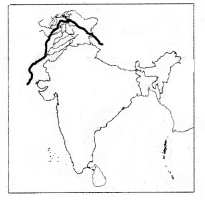
Answer:
River Indus.
Question 4.
Consider the following statements.
1) Human activities are one of the causes of the global warming.
2) Climate change happens at a global level.
Which of the above statements is /are true?
Answer:
Both (1) & (2).
![]()
Question 5.
Western disturbances cause
a) Cyclones in Arabian sea
b) Low to moderate rainfall over northern India.
c) Heavy rains in Coramandal coast.
Answer:
b) Low to moderate rainfall over northern India.
Question 6.
Which factor influences the density of population of a state?
Answer:
Natural resources and production of goods.
Question 7.
Arrange the following in a chronological order.
1. Switzerland women got right to vote
2. State Reorganisation Act
3. SRC was appointed
Answer:
SRC was appointed – State Reorganisation Act – Switzerland women got right to vote.
Question 8.
The words that gave priority to secular and socialistic values are
1. Equality;
2. Liberty;
3. …………………….. ?
Answer:
Justice.
Question 9.
Identify the person in the photograph.

Answer:
Ken Saro Viwa.
Question 10.
Who said that of every rupee spent on poor, barely 15 paise reaches the poor?
Answer:
Rajiv Gandhi.
Question 11.
The three principles of Sun Yat-sen are San, Mm, and Chui. Among these ‘Min’ means …………………. .
Answer:
Democracy
Question 12.
What is meant by “UniversaI Adult Franchise”?
Answer:
Right to vote to all eligible voters.
![]()
Section -II
8 x 2 = 16 M
Note:
1) Answer all the questions.
2) Each question carries 2 marks.
Question 13.
Answer the following questions based on the graph given below.
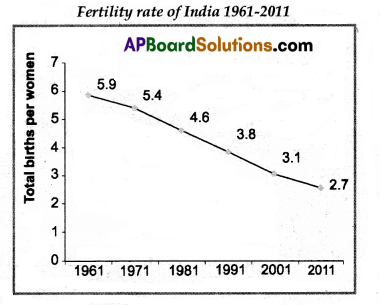
a) What is the fertility rate recorded in 2011?
b) What is the trend of fertility rate during 1961-2011?
Answer:
a) 2.7
b) The fertility rate is decreasing.
Question 14.
Write two slogans to bring awareness on saving of water in consumption?
Answer:
- Save water – save life.
- Water saved is water created.
Question 15.
When compared to 1900, the death rate decreased in the last decade. What is the main reason for this in your opinion?
Answer:
- Improvement in medical facilities
- Improvement in income of the people
- Availability of nutritious food.
Question 16.
Write your caption in the context of development.

Answer:
“There is enough for everybody’s need and not for anybody’s greed.
Question 17.
Who can make changes in the RTI Act?
Answer:
The Parliament has the right to make changes in RTI.
Question 18.
Where were atom bombs used for the first time in the world?
Answer:
Hiroshima and Nagasaki in Japan during World War II by USA on August 6 and 9 in 1945.
Question 19.
How did the Second World War help US to emerge as a superpower?
Answer:
The USA suffered less as the war was not fought on its territories. In fact the Second World War helped USA grow out of its economic misery caused by the great depression.
![]()
Question 20.
Name the countries which have veto power. What is veto power?
Answer:
USA, USSR (Russia), UK, France and China are the countries that have Veto Power. A constitutional/legal right to reject a decision or proposal made by the law-making body.
Section – III
8 × 4 = 32 M
Note:
1) Answer all the questions.
2) Each question carries 4 marks.
Question 21.
Why is it necessary to focus on sustainable development now – a – days?
Answer:
- To meet the needs of the present and future generations.
- To provide better quality of life for everyone.
- To conserve fertility of the soil.
- To reduce water pollution.
- To control emissions of industrial pollutants.
Question 22.
How does the gender bias affect when the women work outside of the home nowadays?
Answer:
Effects of gender bias when women work outside the home.
Positive effects:
- Economic independence
- Develops self-confidence
- Have greater say in household decisions
- Importance in social and political arena
Negative effects:
- Harassment at workplace
- Low wages in comparison to males
- Domestic violence
Question 23.
Observe the bar diagram and answer the questions.
a) What percentage of people in rural India are consuming more calories than are required?
b) What is the reason for consuming less calories than are required in rural India?
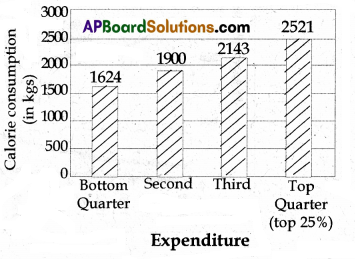
Answer:
a) 25% of people in rural India are consuming more calories than are required.
b) Poverty, unemployment and low purchasing power.
Question 24.
Why do you think the effects of climate change may be felt by all countries?
Answer:
- The climate change is not limited to the geographical extent of the lands of the countries.
- The oceans, the sky, the waters and the air don’t know any barriers.
- They carry the ill effects of climate change ignoring the boundaries of the countries.
- The effects of climate change may be felt by all countries sooner or later.
Question 25.
Read the following paragraph and write your opinion. The poor farmers of dry lands faced the limitations of agricultural production with little and depleting water resources, The artisans faced the problem of decline in demand for their produce and depletion of sources of raw materials like bamboo or wood.
Answer:
- The deforestation affects the farmers and artisans directly and indirectly.
- With the non-availability of wood and bamboo, artisans are facing shortage of raw materials for their handicrafts. This leads to rise in cost of production which results in fall of demand due to rise in prices.
- With acute shortage of water, there is low agricultural productivity. The farmers are unable to get back their investments.
- The governments have to think over these problems and take up measures to solve the problems.
Question 26.
Write any two similarities between the Indian and the Japanese Constitutional preambles.
Answer:
- Sovereign Power
- Democracy
- Liberty
- Justice
- Faith
Question 27.
How do you think the Legal Services Authority would help the people in seeking legal aid?
Answer:
- Our Constitution strongly believes in equal justice and free legal aid for those who cannot afford legal expenditure due to economic or other inabilities.
- Legal Services Authority Act 1987 (amended in 2002) established Lok Ada lats to achieve this aim of free legal service.
- After examining the eligibility/ criteria of an applicant and whether the prima fade of the case is in his/her favour, the Legal Services Authority provides the applicant counsel at State expense.
- It also pays the required court fee and bears all the incidental expenses.
- The applicant need not spend anything on the litigation once the Legal Service Authority supports the applicant.
- In this way Legal Service Authority is a boon to the poor people in achieving free legal aid and judgement in a short period of time.
![]()
Question 28.
How do you appreciate Chipko Movement?
Answer:
The Chipko movement is a movement of afforestation and caring about trees through the act of hugging trees to protect them from being felled. The Chipko movement started in the early 1970s in the Garhwal, Himalayas of Uttarakhand, then in Uttar Pradesh with growing awareness of rapid deforestation. Sundar Lal Bahuguna was the famous social activist in this movement who inculcated awareness among people about the problems of deforestation.
Section – IV
5 x 8 = 40 M
Note:
1) Answer all the questions.
2) Each question carries 8 marks.
3) Each question has internal choice.
4) In question no.33, both A and B (India map and World map) should be answered separately.
Question 29.
A) In what ways is the Indo-Gangetic plain different from the peninsular plateau?
(OR)
B) What are the reasons for the migration of labourers from rural to urban areas? What are the problems faced by them?
Answer:
| Indo-Gangetic plain | Peninsular plateau |
| Location: This plain is located to the south of Himalayas. |
Location: This plain is located to the south of the Indo-Gangetic plain. |
| Extension: It is extended from east to west over a length of 2,400 km and covers an area of 7 lakh sq. km. |
Extension: The north-south extent of the plateau is about 1600 km and east-west extent is about 1400 km. It is triangular in shape and covers an area of 16 lakh sq. km |
| Formation of Terrain: This is formed by silts deposited by the Indus, the Ganga and the Brahmaputra rivers. |
Formation of Terrain: It mainly composed of the old crystalline hard igneous and metamorphic rocks. |
| Soils: This contains fertile alluvial soils of the types the Bhabar, Bhangar and Khadar. It is good for crop cultivation such as Sugarcane, wheat and rice. |
Soils: The plateau is rich in mineral resources with black soil. The region has huge deposits of iron, manganese, copper, bauxite, mica, chromium and limestone. |
| Rivers: Perennial rivers Eg: The Ganga and its tributaries, the Indus and its tributaries, the Brahmaputra. |
Rivers: Not perennial rivers. Eg: the Godavari, the Krishna and the Narmada. |
B) Reasons:
- Migration of people from rural area to urban area is called rural-urban migration.
- Main reasons for migration are unemployment poverty, low and uncertain wages, poor education, poor health and recreation facilities in rural areas.
- This type of migration mostly takes place at initial and medium stages of urbanisation.
- The percentage of rural-urban migration is more.
The different problems faced by the labourers:
- Exposure to different environments.
- Overstress, agony and other psychological problems.
- Non-availability of food they are habituated.
- Home-sickness.
- The length of the migration period.
- New social atmosphere.
- Long hours of work.
- Meagre wages or salaries.
- Unable to fulfil the basic needs until they get any work.
Question 30.
A) Read the paragraph, understand and write your opinion on it.
When industrialisation has brought a lot of material comforts, at least to some it has resulted in a world where natural resources are threatened and now even the climate is being disrupted. This pattern of growth clearly cannot continue.
(OR)
B) “What is required are laws and rules to recognise that water is a common flowing resource. Drinking water is the first priority as well as a human right and that panchayat rai institutions must have control over the use of groundwater.”
Q. Do you think the laws and control of the government on the utilisation of groundwater in a right way are enough? What measures are to be taken up in Your opinion?
Answer:
A) 1. Industrialisation helped to large-scale production. It brought lot of comforts making the living happy and provided luxuries.
2. This is one side of the industrialisation. The second side is that it leads to
- deforestation
- soil erosion
- rising dependence on fossil fuels
- industrial emissions
- use of chemical fertilisers and pesticides in agriculture.
3. These all lead to climate changes, global warming and environmental problems.
Eg: Kerala floods in August 2018.
4. The present generation and future generations too suffer a lot.
5. So, there is a need to broaden the focus of development from material goods and services to all people – present and future generations.
6. The environment should also be sustained saving living and non-living resources.
For this, we have to take measures like:
- To meet the needs of the present and future generations.
- To provide better quality of life for everyone
- To conserve fertility of the soil
- To reduce water pollution
B)
- nowadays, there is growing awareness on usage of water
- Every drop of Water is to be saved.
- The governments are making laws and controlling utilisation of groundwater.
- Groundwater is also a public property concerning all the people around it. Everyone has right to use it.
- The government has to take serious action against indiscriminate digging of bore wells and the overdrawing of water.
- However, the public should feel the responsibility. They should have collective responsibility in caring ground water.
- Unless public feels the responsibility, the government can’t administer the laws. The present laws and control of government in a right way are enough.
![]()
Question 31.
A) Observe the graph and analyse it.
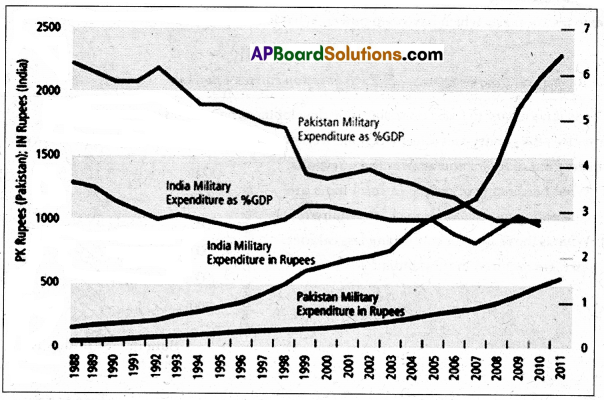
B) Observe the following table and write a paragraph analysing it.
| Rank in total emissions in 2011 | Country | 2011 total Carbon dioxide emissions from the consumption of Energy (Million metric tons) | Per capita Carbon dioxide emissions from the consumption of Energy (Metric tons) |
| 1 | China | 8715.31 | 6.52 |
| 2 | USA | 5490.63 | 17.62 |
| 3 | Russia | 1788.14 | 12.55 |
| 4 | India | 1725.76 | 1.45 |
| 11 | UK | 496.80 | 7.92 |
| 15 | Indonesia | 426.79 | 1.73 |
Answer:
A)
- The graph shows the military expenditure of India and Pakistan during 1988 – 2011.
- Military expenditure of India in 1988 was less compared to 2011. But we can understand that there is a gradual decrease in expenditure GDP-wise.
- India is spending more on the military.
- The conflicts between India and Pakistan made them suspect each other. With the fear of war, both of them are spending on the military.
- Bilateral discussions and peace talks between these two Countries reduce tension.
B)
- The table is about the carbon dioxide emissions by China, USA, Russia, India, UK and Indonesia.
- China ranks 1st in emissions and Indonesia is last.
- Over-utilisation of resources leads to environmental and ecological disturbances.
- Using energy requirements for rapid industrialisation is done by all the countries.
- Overuse of fossil fuels, and release of CFCs (Chioro Fluoro Carbons) is dangerous to the nature.
- Industrial nations must adopt the latest technology for the effective use of renewable sources of energy.
- An international organisation called IPCC (Inter-Government Panel on Climate Change) formed, to address this issue.
- The Green Peace movement which started in Europe has developed the idea of sustainable development for the welfare of all.
Question 32.
A) Russian Revolution brought in many changes in their society. What are they?
(OR)
B) Write about the advantages and problems the people faced, due to the construction of dams.
Answer:
A)
a)
- Land of nobles and church was confiscated and given to peasant societies. Land was declared as state property.
- Private property was eliminated. Industries were nationalised.
- A system of centralised planning by the state started. Five-year plans were introduced. Planning helps growth of economy.
- Education developed.
- The Tsar’s empire was transformed into a new state called USSR.
- Cheap public healthcare was provided for all.
- Equality of all nationalities and autonomy to develop their languages and culture were recognised in the constitution.
- Within a few years, Russia emerged as a major power of the world.
b) Challenges faced:
- Peasants who resisted collective framing had to face imprisonment, deportation and even death.
- The white armies of the Russian monarchists posed a big problem.
- Anti-Communist Soldiers also attacked the civilians and government institutions.
- A severe famine in 1929-30 was a great challenge.
- The people had to work very hard in poor working conditions.
- For many people survival itself became a challenge as the resources were not sufficient
B) Advantages :
- Storage of huge amounts of water
- Irrigation
- Flood control
- Drought control
- Generation of hydel power
Problems:
- Loss of fertile land
- Loss of forest land
- Loss of animal life
- Displacement of people from the cultural and traditional lands.
- Huge expenditure.
Question 33.
A)
a) Locate the following in the outline map of India given.
1. The state that gets abundant rainfall from northeast monsoon.
2. The city in which Indira Gandhi International Airport is situated.
3. Indian Standard Meridian.
4. The River that flows in Thar Desea
(OR)
b) Locate the places on the outline np of India.
1. The Indus
2. The Ganga
3. The Godavari
4. River Luni.
Answer:
A)
a)
1. Tamilnadu
2. New Delhi
3. 82°30’ E. longitude
4. Kerala
(OR)
b)
1. The Indus, The Ganga
2. The Godavari
3. Western Chats
4. River Luni
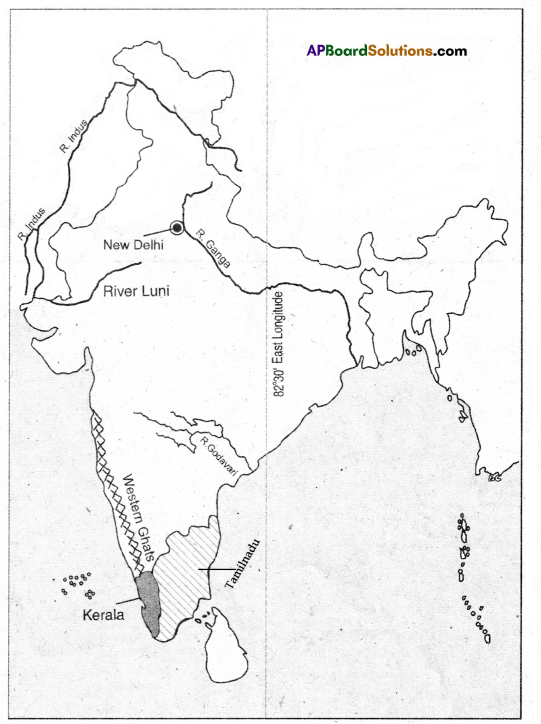
![]()
B) Locate the following in the given map of the World.
a)
1) Capital city of France
2) Nepal
3) Israel
4) Cuba
(OR)
b)
1) Finland
2) Poland
3) Capital city of Italy
4) Amsterdam
Answer:
a)
1) Paris
2) Nepal
3) Israel
4) Cuba
(OR)
b)
1) Finland
2) Poland
3) Capital city of Italy
4) Amsterdam
